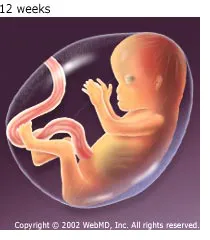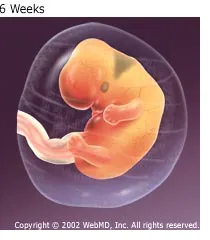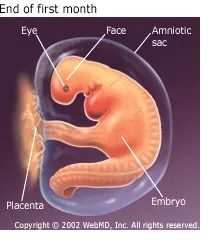Week 17
Baby:Your baby, now about in its 15th week of development, measures about 4.4 to 4.8 inches from crown to rump and has doubled in weight in the last two weeks to about 3.5 ounces. Fat begins to form, helping your baby's heat production and metabolism. The lungs are beginning to exhale amniotic fluid, and the circulatory and urinary systems are working. Hair on head, eyebrows and eyelashes is filling in.
Mom-to-be: You're showing more now, with an obvious swelling in your lower abdomen. A five- to 10-pound weight gain is typical by now. You also may be noticing an increase in appetite.
If you are newly pregnant, or trying to conceive, you have many questions about what to expect. How will your body change? What's happening inside you? Here's what to expect week by week.
Tip of the Week: Change positions slowly, especially when you move from a lying down position to sitting or from a sitting position to standing to avoid feeling dizzy or faint. If you feel lightheaded, sit down and lower your head, or lie down for a moment.
Week 18
Baby: Your baby measures 5 to 5.6 inches from crown to rump and weighs about 5.25 ounces. The rapid growth spurt is tapering off, but reflexes are kicking in. It can yawn, stretch and make facial expressions, even frown. Taste buds are beginning to develop and can distinguish sweet from bitter tastes. The baby will suck if its lips are stroked and it can swallow, and even get the hiccups. The retinas have become sensitive to light, so if a bright light is shined on your abdomen, baby will probably move to shield its eyes.
Mom-to-be: Your uterus, about the size of a cantaloupe, can probably be felt just below your navel. You're most likely feeling the baby move by now. A mid-pregnancy ultrasound may be performed between now and 22 weeks to assess fetal growth and development and to verify the due date. If the baby is in the right position, the ultrasound may even be able to determine whether it's a boy or a girl. Your heart has to work 40 percent to 50 percent harder now to support your pregnancy.
Tip for the Week: Suggest that your partner go with you for the ultrasound. It's a chance to catch the first glimpse of your baby together, as well as provide a snapshot to show friends and family later. Sonograms still don't guarantee a healthy baby, but they can provide reassurance and spot some problems.
Week 19
Baby: Your baby measures about 5.2 to 6 inches from crown to rump and weighs about 7 ounces. Skin is developing and transparent, appearing red because blood vessels are visible through it. Creamy white protective coating, called vernix, begins to develop.
Mom-to-be: As your baby continues to grow, you may be feeling some mid-pregnancy aches and pains by now -- lower abdominal achiness, dizziness, heartburn, constipation, leg cramps, mild swelling of ankles and feet, and a backache. Dilated blood vessels might cause tiny, temporary red marks (called spider nevi) on your face, shoulders and arms.
Tip of the Week: Take care not to get overtired since rapid growth of the baby can compound the burden on your heart, lungs and kidneys.


 As the fertilized egg grows, a water-tight sac forms around it, gradually filling with fluid. This is called the amniotic sac, and it helps cushion the growing embryo.
As the fertilized egg grows, a water-tight sac forms around it, gradually filling with fluid. This is called the amniotic sac, and it helps cushion the growing embryo.